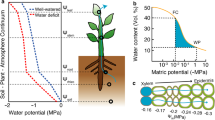Abstract
Rates of transpiration and xylem sap flow were continuously measured in individual twigs in the upper crown of an 18-year-old spruce. Two gas exchange chambers were run simultaneously under identical conditions. One of two equivalent twigs was exposed to pure air whereas the other received the ozone-enriched air of the site. A third gas exchange chamber in mid-crown ran independently with normal outside air and was used for basic experiments. At certain times needles were sampled for water potential measurements. Chamber humidity was reduced step by step and the transpiration and xylem sap flow rates were permanently compared. It turned out that sap flow keeps up with transpiration without lagging as long as chamber humidity is high and the twigs outside the chamber are not subject to substantial evaporative demand. However, in warm summer weather and with high flow rates sap flow is no longer sufficient. As the balance quotient (uptake/release) of 0.8 was reached the stomata began to close and water balance improved. The flux quotient increased far above 1.0 without water potential of the needles, which had decreased before, increasing significantly. The balance quotient of the twig in ozone-enriched air fell to relatively low values and only increased again correspondingly slowly due to lagging stomatal closure. Despite increased water uptake after the light phase, the ozone-treated twig ran into a water deficit in the daily balance during the course of an uninterrupted drought period. Water deficit increased from day to day and only disappeared with the next rainfall. For providing insight into the ozone effect shown in this study it was thought necessary to discuss comprehensively the controversial views of the stomatal control mechanism. The results show that the stomata react to small scale changes in water status as expected for an effective negative feedback system. The less sensitive reaction of the stomata under the influence of ozone confirms earlier results. Increased severity and duration of the daily drought stress loads were attributed to a lag in adjustment due to poor stomatal control. The demonstrated function mechanism shows that the detrimental effect of ozone is dependent on weather conditions.
Similar content being viewed by others
Author information
Authors and Affiliations
Additional information
Received: 12 April 1996 / Accepted: 24 June 1996
Rights and permissions
About this article
Cite this article
Maier-Maercker, U. Experiments on the water balance of individual attached twigs of Picea abies (L .) Karst. in pure and ozone-enriched air. Trees 11, 229–239 (1997). https://doi.org/10.1007/PL00009669
Issue Date:
DOI: https://doi.org/10.1007/PL00009669




